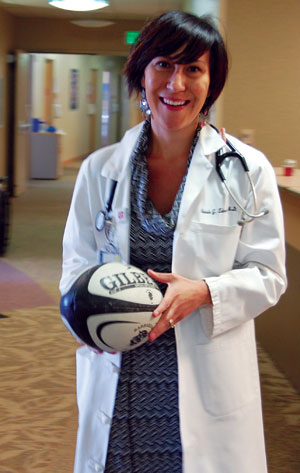Final Thoughts
By Nichole Zehnder, MD
 (
(
Let me explain: A hooker is a rugby player at the center of the action. For those unfamiliar with a rugby scrum, think of it as a set of human bowling pins lined up in reverse. The front row has three players, and the hooker hangs in the middle between two players called “props.”
When the ball enters play, the opposing scrums crouch and, as a carefully orchestrated mass of force, use their shoulders to drive the opposing team away from the ball. Arms clinging to the bookend props, the hooker’s entire job is to “hook” the ball with her foot, kicking it back to teammates whose job is to run up the field and score.
Rugby is an amazing sport that requires practice, rewards teamwork and encourages camaraderie. Medical education is similar.
This year, our inpatient internal medicine clerkship replaced our traditional lecture series with
Not much in our world can get done without teams. This is as true in medicine as it is on the rugby pitch. After a few years as a hooker smack dab in the middle of the scrum, I am absolutely certain that rugby and team-based learning operate in a parallel universe.
As a rugby player, this meant countless hours of tackling drills. It meant running sprints in the freezing rain, in the mud
In the same way, in TBL, we expect our learners to come prepared. Each week they are required to read pre-specified chapters of
Imagine a 100-seat classroom, but in TBL, teams gather facing each other instead of the facilitator. Each session starts with teams taking a brief readiness assessment test, working together to achieve the best score possible.
After each team has taken their test, scores are posted at the front of the room for others to see. Just like players on the pitch, students want the best score. They want to win.
The subsequent part—after the warm-up test—makes TBL really fun. Teams work through clinical cases in parts, with
Finally, what makes both rugby and TBL incredible is genuine camaraderie.
After games, ruggers head to a nearby pub to celebrate and perhaps watch a less fortunate teammate “shoot the boot” (drink beer from a cleat). No one takes attendance, but everyone always is there. Teams stick together.
Now if you are wondering how this fits into TBL, let me end with a little story.
During each course block, the team of learners spends the second half of their clinical rotation at remote clinical sites, separated from one another. They disperse, isolated from their team by hundreds of miles.
Less than a week after one team went out on their own, I got an email from their “team captain” that said: “Dear Dr. Zehnder, our team met on Google Hangout to go over these cases together. We had a couple of questions we hoped you could answer.”
Despite being miles apart, the team continued to work together to solve clinical conundrums.
Nichole Zehnder, MD, is an assistant professor of medicine.